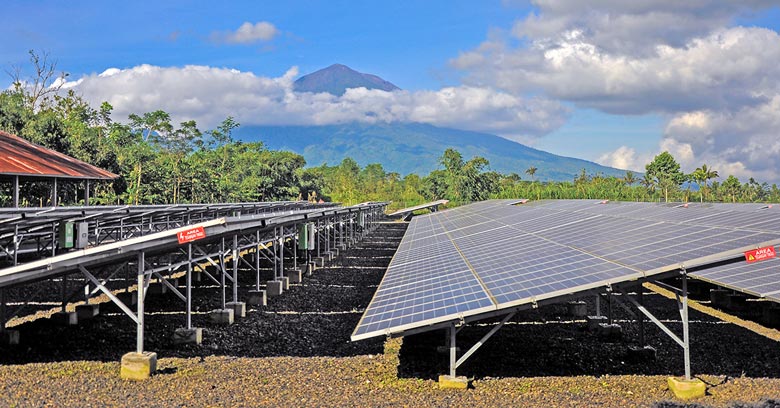
In 2021, the government rolled out two important regulations showing strong support for investments in renewable energy. Its neighbouring country, Singapore, signed two agreements on the same day to import solar energy from Indonesia. A recent finding by the Australian National University reveals that Indonesia’s solar power system could reach 190,000 TWh in 2050, far more than the nation’s total demand.
Long-awaited Boost by the Government in the Renewable Energy Sector
So far in 2021, the Indonesian government has issued two important regulations, the energy ministry’s Regulation No. 26/2021, addressing the use of rooftop solar power systems, and the Electricity Procurement Plan (RUPTL) for 2021-2030. The two regulations are expected to support the goal to have renewable energy make up 23% of the country’s total energy mix by 2025.
Energy ministry Regulation No. 26 amended the previous 2018 solar rooftop regulation with one notable point. Independent power producers (IPPs) that signed power purchase agreements (PPAs) with the state-owned power company PLN will now be able to export 100% (instead of 60%) of the electricity generated by rooftop solar panels. While the regulation is still under debate, it would undeniably improve the investment appeal in solar rooftop systems.
Moreover, the RUPTL 2021-2030, released by PLN, sets the target that renewable energy should account for 51.6% of the national energy mix by 2030, a significant increase from the 30% target set out in the RUPTL released in 2019. PLN plans to build 40.6 GW-worth of new power plants through 2030, 20.9 GW of which would be from renewable resources. Hydropower would account for around half of the new renewable energy resources, solar for 4.7 GW, and geothermal for 3.35 GW.
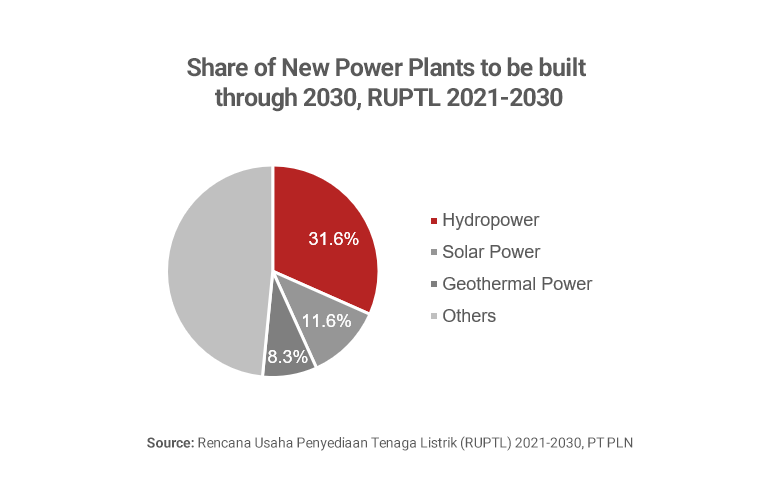
PLN’s plan aligns with the government’s zero-carbon pledge by 2060. The coal-dominated power sector is one of the largest contributors to Indonesia’s carbon emissions. Indonesia’s long dependence on coal power plants has lately been more precarious as China, a major investor in Indonesian coal power plants, pledged to halt investment in coal power abroad. Slowed drafting of supportive regulations, coupled with the nature of the business requiring high initial costs and low return on investment, made investments in renewable energy unattractive. On average, the Indonesian installed capacity of renewable energy has only grown by 4% since 2012, compared to more than 10% in Malaysia, Singapore, Vietnam and Thailand.
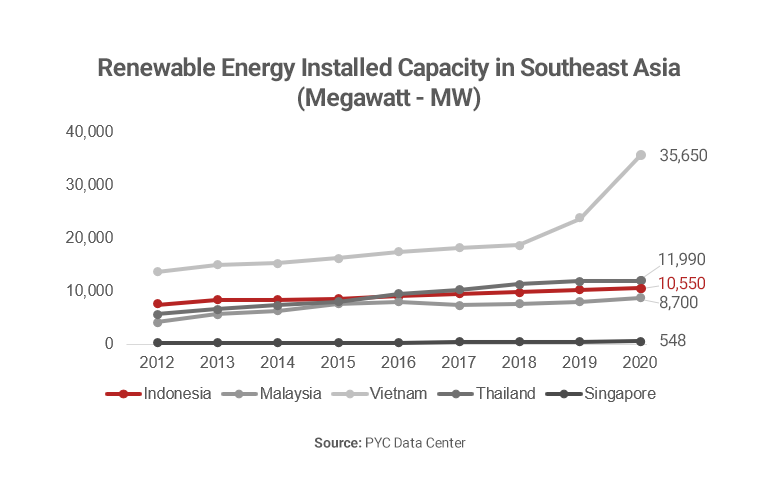
Several further steps need to be taken to achieve the government’s ambitious goals, including finalizing the laws for renewable energy and the presidential regulations for pricing and procurement for renewable energy. Additionally, an optimum energy transition roadmap is required to strike a balance between environmental conservation and sufficient energy supply.
Major Cross-Border Solar Power Projects
Multiple promising solar power projects were recently announced by the government, including exporting deals with Singapore and Southeast Asia’s largest floating solar power project with the United Arab Emirates. The projects, as interpreted by experts, are signals of an export-intensive strategy in which local and international companies seek to export green energy from Indonesia to its neighbours.
Two Joint Development Agreements (JDAs) were signed on October 25, 2021, by Singaporean companies for the import of solar energy from Indonesia. One was signed by Singapore’s Sembcorp Industries, which announced that the joint development plan would include the development of a large-scale integrated solar and energy storage in Indonesia’s Batam, Bintan, and Karimun (BBK) region. Another JDA, signed by PacificLight Power (PLP) – a Singaporean-based power retail company, and a consortium of Indonesian power companies, was for a 100MW pilot solar export project from Indonesia to Singapore. The JDAs were signed after Singaporean Minister for Trade and Industry announced Singapore’s plan to import around 30% of its electricity from low-carbon sources by 2035.
After a financing agreement between PLN and Masdar of the United Arab Emirates, Indonesia began working on a 145 MW floating solar power project, the largest in Southeast Asia, on August 3, 2021,. The project is scheduled to begin commercial operation in November 2022. A similar plan will also be developed in eight other reservoirs in Java and Sumatra.
Vast Potential in Indonesia’s Solar Energy Sector
A recent study published by the 100% Renewable Energy team at the Australian National University (ANU) outlined that Indonesia’s potential in solar energy is far larger than the potential in any other energy sources, and much higher than needed nationally.
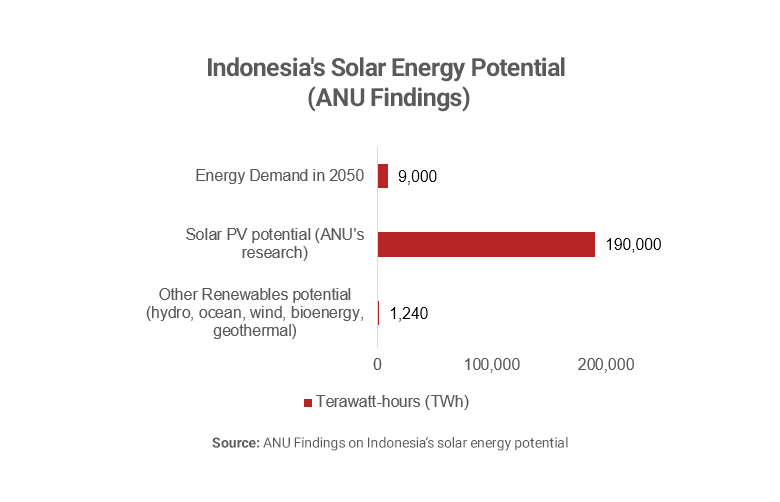
The research team forecasts that Indonesia could harvest 10 billion solar panels by 2050. The panels could be distributed across the archipelago, from rooftops, abandoned coal mine sites and agriculture sites, to floating on the country’s inland sea, lakes, and reservoirs.
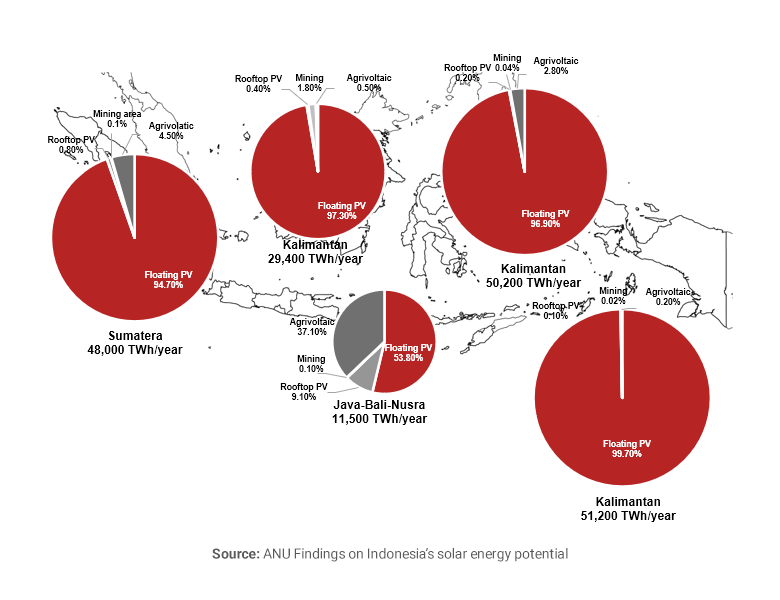
The Indonesian Ministry of Energy and Mineral Resources reported a total of 154 MW of installed solar panels as of 2020. That is far below Vietnam (16,500 MW) and even less than Singapore (377 MW). However, the new improvements in regulations and the influx of solar projects could significantly change the Indonesian current standing.
Indonesia has tremendous opportunities to become a major exporter of solar power. The latest regulations signify the government’s focus on the sector, which helps boost interest in solar investments. The newly signed projects with Singapore also prove Indonesia’s prospect in selling its vast solar power potential to neighbouring countries.
Read more about our market entry and expansion services or our energy & environment expertise.
The insights provided in this article are for general informational purposes only and do not constitute financial advice. We do not warrant the reliability, suitability, or correctness of the content. Readers are advised to conduct independent research and consult with a qualified financial advisor before making any investment decisions. Investing in financial markets carries risks, including the risk of loss of principal. Past performance does not guarantee future results.
The views expressed herein are those of the author(s) and do not necessarily reflect the company's official policy. We disclaim any liability for any loss or damage arising from the use of or reliance on this article or its content. ARC Group relies on reliable sources, data, and individuals for its analysis, but accuracy cannot be guaranteed. Forward-looking information is based on subjective judgments about the future and should be used cautiously. We cannot guarantee the fulfillment of forecasts and forward-looking estimates. Any investment decisions based on our information should be independently made by the investor.
Readers are encouraged to assess their financial situation, risk tolerance, and investment objectives before making any financial decisions, seeking professional advice as needed.



